Trade names Platinol, others MedlinePlus a684036 ATC code L01XA01 (WHO) CAS ID 15663-27-1 | AHFS/Drugs.com Monograph Molar mass 300.01 g/mol | |
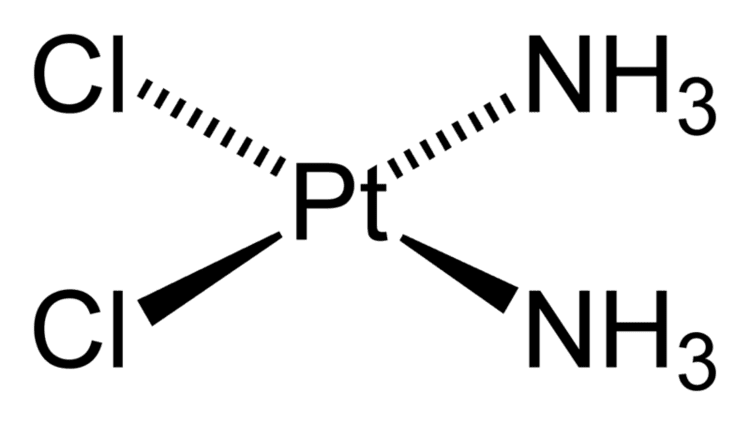 | ||
Pregnancycategory US: D (Evidence of risk) | ||
How to pronounce cisplatin platinol memorizing pharmacology video flashcard
Cisplatin is a chemotherapy medication used to treat a number of cancers. This includes testicular cancer, ovarian cancer, breast cancer, bladder cancer, head and neck cancer, cervical cancer, lung cancer, mesothelioma, esophageal cancer, brain tumors, and neuroblastoma. It is used by injection into a vein.
Contents
- How to pronounce cisplatin platinol memorizing pharmacology video flashcard
- Medical use
- Side effects
- Mechanism of action
- Cisplatin resistance
- Transplatin
- History
- Synthesis
- References

Common side effects include bone marrow suppression, hearing problems, kidney problems, and vomiting. Other serious side effects include numbness, trouble walking, allergic reactions, electrolyte problems, and heart disease. Use during pregnancy is known to harm the baby. Cisplatin is in the platinum-based antineoplastic family of medications. It works in part by binding to and blocking the duplication of DNA.

Cisplatin was discovered in 1845 and licensed for medical use in 1978. It is on the World Health Organization's List of Essential Medicines, the most effective and safe medicines needed in a health system. The wholesale cost in the developing world is about 5.56 to 7.98 USD per 50 mg vial. In the United Kingdom this costs the NHS about 17 pounds.
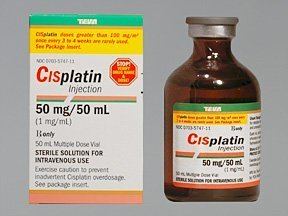
Medical use

Cisplatin is administered intravenously as short-term infusion in normal saline for treatment of solid malignancies. It is used to treat various types of cancers, including sarcomas, some carcinomas (e.g., small cell lung cancer, squamous cell carcinoma of the head and neck and ovarian cancer), lymphomas, bladder cancer, cervical cancer, and germ cell tumors.
Cisplatin is particularly effective against testicular cancer; the cure rate was improved from 10% to 85%.
In addition, cisplatin is used in Auger therapy.
Side effects
Cisplatin has a number of side-effects that can limit its use:

Mechanism of action
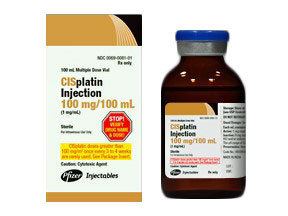
Cisplatin interferes with DNA replication, which kills the fastest proliferating cells, which in theory are carcinogenic. Following administration, one of the two chloride ligands is slowly displaced by water to give the aquo complex cis-[PtCl(NH3)2(H2O)]+, in a process termed aquation. Dissociation of the chloride ligand is favored inside the cell because the intracellular chloride concentration is only 3–20% of the approximately 100 mM chloride concentration in the extracellular fluid.
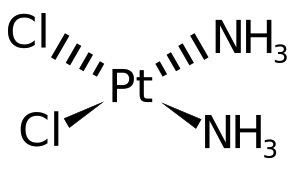
The aqua ligand in cis-[PtCl(NH3)2(H2O)]+ is itself easily displaced by the N-heterocyclic bases on DNA. Guanine preferentially binds. Subsequent to formation of [PtCl(guanine-DNA)(NH3)2]+, crosslinking can occur via displacement of the other chloride ligand, typically by another guanine. Cisplatin crosslinks DNA in several different ways, interfering with cell division by mitosis. The damaged DNA elicits DNA repair mechanisms, which in turn activate apoptosis when repair proves impossible. In 2008, researchers were able to show that the apoptosis induced by cisplatin on human colon cancer cells depends on the mitochondrial serine-protease Omi/Htra2. Since this was only demonstrated for colon carcinoma cells, it remains an open question if the Omi/Htra2 protein participates in the cisplatin-induced apoptosis in carcinomas from other tissues.
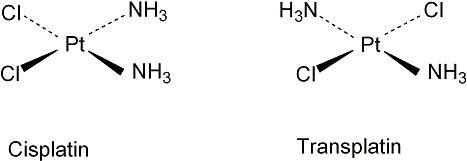
Most notable among the changes in DNA are the 1,2-intrastrand cross-links with purine bases. These include 1,2-intrastrand d(GpG) adducts which form nearly 90% of the adducts and the less common 1,2-intrastrand d(ApG) adducts. 1,3-intrastrand d(GpXpG) adducts occur but are readily excised by the nucleotide excision repair (NER). Other adducts include inter-strand crosslinks and nonfunctional adducts that have been postulated to contribute to cisplatin's activity. Interaction with cellular proteins, particularly HMG domain proteins, has also been advanced as a mechanism of interfering with mitosis, although this is probably not its primary method of action.

Although cisplatin is frequently designated as an alkylating agent, it has no alkyl group and it therefore cannot carry out alkylating reactions. It is correctly classified as alkylating-like.
Cisplatin resistance

Cisplatin combination chemotherapy is the cornerstone of treatment of many cancers. Initial platinum responsiveness is high but the majority of cancer patients will eventually relapse with cisplatin-resistant disease. Many mechanisms of cisplatin resistance have been proposed including changes in cellular uptake and efflux of the drug, increased detoxification of the drug, inhibition of apoptosis and increased DNA repair. Oxaliplatin is active in highly cisplatin-resistant cancer cells in the laboratory; however, there is little evidence for its activity in the clinical treatment of patients with cisplatin-resistant cancer. The drug paclitaxel may be useful in the treatment of cisplatin-resistant cancer; the mechanism for this activity is unknown.
Transplatin
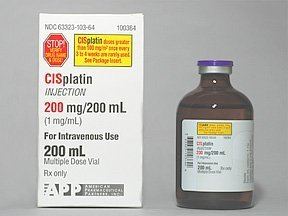
Transplatin, the trans stereoisomer of cisplatin, has formula trans-[PtCl2(NH3)2] and does not exhibit a comparably useful pharmacological effect. Its low activity is generally thought to be due to rapid deactivation of the drug before it can arrive at the DNA. It is toxic, and it is desirable to test batches of cisplatin for the absence of the trans isomer. In a procedure by Woollins et al., which is based on the classic Kurnakov test, thiourea reacts with the sample to give derivatives which can easily be separated and detected by HPLC.
History
The compound cis-[Pt(NH3)2(Cl)2] was first described by Michele Peyrone in 1845, and known for a long time as Peyrone's salt. The structure was deduced by Alfred Werner in 1893. In 1965, Barnett Rosenberg, Van Camp et al. of Michigan State University discovered that electrolysis of platinum electrodes generated a soluble platinum complex which inhibited binary fission in Escherichia coli (E. coli) bacteria. Although bacterial cell growth continued, cell division was arrested, the bacteria growing as filaments up to 300 times their normal length. The octahedral Pt(IV) complex cis-[PtCl4(NH3)2], but not the trans isomer, was found to be effective at forcing filamentous growth of E. coli cells. The square planar Pt(II) complex, cis-[PtCl2(NH3)2] turned out to be even more effective at forcing filamentous growth. This finding led to the observation that cis-[PtCl2(NH3)2] was indeed highly effective at regressing the mass of sarcomas in rats. Confirmation of this discovery, and extension of testing to other tumour cell lines launched the medicinal applications of cisplatin. Cisplatin was approved for use in testicular and ovarian cancers by the U.S. Food and Drug Administration on 19 December 1978., and in the UK (and in several other European countries) in 1979.
Synthesis
The synthesis of cisplatin starts from potassium tetrachloroplatinate. The tetraiodide is formed by reaction with an excess of potassium iodide. Reaction with ammonia forms K2[PtI2(NH3)2] which is isolated as a yellow compound. When silver nitrate in water is added insoluble silver iodide precipitates and K2[Pt(OH2)2(NH3)2] remains in solution. Addition of potassium chloride will form the final product which precipitates In the triiodo intermediate the addition of the second ammonia ligand is governed by the trans effect.
For the synthesis of transplatin K2[PtCl4] is first converted to Cl2[Pt(NH3)4] by reaction with ammonia. The trans product is then formed by reaction with hydrochloric acid.
